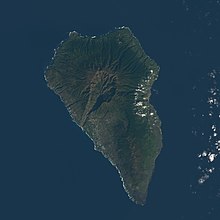
The island of La Palma in the Canary Islands is at risk of undergoing a large landslide, which could cause a tsunami in the Atlantic Ocean. Volcanic islands and volcanoes on land frequently undergo large landslides/collapses, which have been documented in Hawaii for example. A recent example is Anak Krakatau, which collapsed to cause the 2018 Sunda Strait tsunami.
Steven N. Ward and Simon Day in a 2001 research article proposed that a Holocene change in the eruptive activity of Cumbre Vieja volcano and a fracture on the volcano that formed during an eruption in 1949 may be the prelude to a giant collapse. They estimated that such a collapse could cause tsunamis across the entire North Atlantic and severely impact areas as far away as North America. Later research has debated whether the tsunami would still have a significant size far away from La Palma, as the tsunami wave may quickly decay in height away from the source and interactions with the continental shelves could further reduce its size. Evidence indicates that most collapses in the Canary Islands took place as multistage events that are not as effective at creating tsunamis, and a multi-stage collapse at La Palma likewise would result in smaller tsunamis.
The recurrence rate of similar collapses is extremely low, about one every 100,000 years or less in the case of the Canary Islands. Other volcanoes across the world are at risk of causing such tsunamis.
